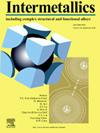预氧化处理提高zr基金属玻璃的耐蚀磨损性能
IF 4.8
2区 材料科学
Q2 CHEMISTRY, PHYSICAL
引用次数: 0
摘要
zr基大块金属玻璃(bmg)由于其优异的力学性能和玻璃成形能力而被认为具有广阔的应用前景。然而,zr基bmg的耐磨性不足,特别是暴露于腐蚀性液体环境时,可能会降低其在特殊环境中的使用可靠性。在这里,我们报告了一种简单的方法,可以显著提高zr基MBGs的腐蚀磨损性能,称为预氧化处理(PT)。电化学实验的关键参数表明,PT样品具有较低的腐蚀倾向,在3.5% NaCl中性溶液和1N HCl酸性溶液中,PT样品的磨损率分别为1.55 × 10−6 mm3 N−1 m−1和0.88 × 10−6 mm3 N−1 m−1,显著低于铸态(AC)样品的磨损率(29.8 × 10−6 mm3 N−1 m−1和44.99 × 10−6 mm3 N−1 m−1)。AC和PT试样均经历腐蚀和机械磨损的协同作用,AC试样主要经历磨粒磨损、粘接磨损、疲劳磨损,轻微氧化磨损伴腐蚀磨损。PT样品具有高硬度的氧化层,磨损碎屑和腐蚀产物能形成润滑,具有较好的机械磨损性能,使轻度磨粒和腐蚀磨损成为主要的磨损机制。我们的研究结果表明,PT可以显著提高金属玻璃的腐蚀磨损耐久性,从而在腐蚀性服务环境中释放工程潜力。本文章由计算机程序翻译,如有差异,请以英文原文为准。
Improvement of corrosion-wear resistance of Zr-based metallic glass by pre-oxidation treatment
Zr-based bulk metallic glasses (BMGs) are considered to have broad application prospects due to their superior mechanical properties and excellent glass forming ability (GFA). However, the wear resistance of Zr-based BMGs, especially when exposed to corrosive liquid environments, is insufficient and could decrease their service reliability in special environments. Here, we report a facile method that can significantly enhance the corrosion-wear performance of Zr-based MBGs, termed as pre-oxidation treatment (PT). The key parameters of electrochemical experiments proved that PT samples have a lower tendency to corrosion, the wear rates of the PT samples in 3.5 % NaCl neutral solution and 1N HCl acidic solution were 1.55 × 10−6 mm3 N−1 m−1 and 0.88 × 10−6 mm3 N−1 m−1, respectively, which are significantly lower than those of the As-cast (AC) samples (29.8 × 10−6 mm3 N−1 m−1 and 44.99 × 10−6 mm3 N−1 m−1, respectively). AC and PT samples both experienced synergistic effects of corrosion and mechanical wear, AC samples primarily experienced abrasive, adhesive, fatigue, and minor oxidative wear with corrosive wear. PT samples, with a high-hardness oxide layer, the wear debris and corrosion products could form lubrication, shown better resistance to mechanical wear, making mild abrasive and corrosive wear their main wear mechanisms. Our results demonstrates that PT can significantly enhance the corrosion-wear durability of metallic glasses, thereby unlocking engineering potential in corrosive-service environments.
求助全文
通过发布文献求助,成功后即可免费获取论文全文。
去求助
来源期刊

Intermetallics
工程技术-材料科学:综合
CiteScore
7.80
自引率
9.10%
发文量
291
审稿时长
37 days
期刊介绍:
This journal is a platform for publishing innovative research and overviews for advancing our understanding of the structure, property, and functionality of complex metallic alloys, including intermetallics, metallic glasses, and high entropy alloys.
The journal reports the science and engineering of metallic materials in the following aspects:
Theories and experiments which address the relationship between property and structure in all length scales.
Physical modeling and numerical simulations which provide a comprehensive understanding of experimental observations.
Stimulated methodologies to characterize the structure and chemistry of materials that correlate the properties.
Technological applications resulting from the understanding of property-structure relationship in materials.
Novel and cutting-edge results warranting rapid communication.
The journal also publishes special issues on selected topics and overviews by invitation only.
 求助内容:
求助内容: 应助结果提醒方式:
应助结果提醒方式:


